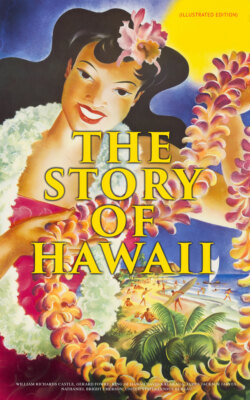Читать книгу The Story of Hawaii (Illustrated Edition) - Fowke Gerard - Страница 34
На сайте Литреса книга снята с продажи.
Lava fountain erupts from Mauna Ulu
ОглавлениеOne trip into the crater of Kilauea is not enough. Every visitor should get to know the lake of fire as well by day as by night, for, as Dr. Perrett says, although it is more spectacular by night, it is far more interesting by daylight, when its constant changes can be seen. And when in addition to the Volcano there are so many other attractions in the neighbourhood a week is none too long a time to stay, and two weeks are exactly twice as good as one.
The summit crater of Mauna Loa, Mokuaweoweo, is smaller than Kilauea, but is still the second largest active volcano in the world. This crater, three and three-quarters miles long by one and one-quarter wide, is about 400 feet deep. When in action it is quite as spectacular as is Kilauea, and is often much more so, but as its activity occurs only at irregular intervals of several years, the man who happens to ascend the mountain at just the right time is very fortunate. In 1880 a man was alone at the summit. He slept in a little tent at the edge of the crater, which was as usual dark. During the night he was waked by a dazzling light, and rushing from his shelter saw playing in the centre of the crater a jet of lava which spouted nearly a thousand feet into the air. The top of this fountain was visible from the shores of the Island and from the ocean for miles around. Such an experience comes to but few men, and the long, difficult ascent of the mountain, as well as the great altitude, will always prevent many people from visiting this volcano even during its rare eruptions.
As a general rule activity in this summit crater is preliminary to a lava flow which breaks out somewhere along the sides of the mountain. The fluid mass finds its way to the crater, and its subsequent outbreak lower down is a natural enough phenomenon when one considers the enormous weight and the consequent lateral pressure of a column of liquid lava rising nearly 14,000 feet above sea level and no one knows from how far below. The only extraordinary thing is that it does not more quickly find some weak spot in the side of the tube and break through long before reaching the summit crater. Of these lava flows there have been eleven during the last century, nine from Mauna Loa, one from Hualalai, and one from Kilauea. Three times the town of Hilo has been threatened, the lava once coming within a mile. So far as is known, however, no lives have been lost in any of these flows. The lava breaks out far up on the uninhabited slopes, is very liquid, and therefore runs fast at first, but it cools rapidly, banks up, and has to break through its own embankments, so that by the time it approaches the sea it advances at the rate of only a few yards each day. So certain is this action that people who go to see the flows camp directly in front of them, moving their tents only when the lava gets near enough to be uncomfortably warm. In the rare instances when flows have reached the sea anywhere along a precipitous coast, the sight from boats, of the molten lava pouring over the cliffs and crashing in clouds of steam into the sea, has been indescribably impressive.
Hawaii is, of course, still in the process of building. Its lavas are so liquid, so thoroughly fused, however, that the danger of explosive volcanic outbreaks is reduced to a minimum. A rancher on the uplands is wise to take account of the one chance in a million and build his house on a hill, rather than in a depression, so that no sudden flow can overwhelm him. Any man owning an upland ranch has always before him the impleasant possibility of waking some morning to find that a section of his best pasture land is being buried under a layer of hard, sterile rock, and the knowledge that in anywhere from a thousand to ten thousand years this rock will have disintegrated into splendidly fertile soil is no immediate consolation. No man, on the contrary, ever lives in fear of his life because of the volcanoes. The people who live in the hotels near Kilauea have rightly no more thought of danger than have those who live in hotels on the Atlantic sea-board. And this "volcanic safety," as it might be called, is not merely the result of long years of immunity. It is corroborated by the highest scientific authority. The tourist, therefore, in making the trip to Kilauea need think only that he is going to see the most magnificent spectacle which the world affords, that he is to have one of the most thrilling experiences of his life, with no more personal danger than he would incur in a railroad trip from Boston to New York. And if he still feels that the goddess of fire should be propitiated, let him follow the old Hawaiian custom of throwing a few ohelo berries into the burning lake as a sacrifice to Pele. Perhaps she will reward him by forcing upward an extra lava fountain that will spray out into a great bouquet made up of all the colours of all the gorgeous flowers of the Orient.
